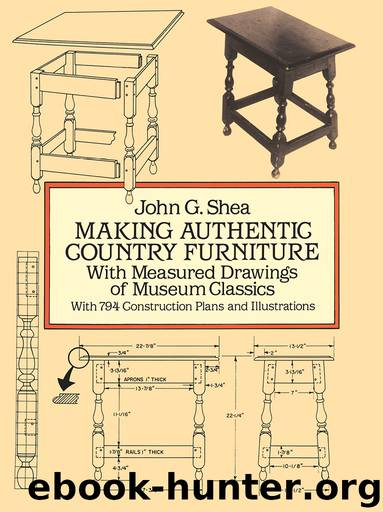Making Authentic Country Furniture by John G. Shea

Author:John G. Shea
Language: eng
Format: epub
Publisher: Dover Publications
A popular stencil design for Hitchcock chairs. Finely ground bronze powders in golden colors are used for this artwork. (Courtesy, The Hitchcock Chair Co.)
Black button-back, crown-top Hitchcock chair was first made between 1825 and 1832. (Courtesy, The Hitchcock Chair Co.)
Another popular early design of Hitchcock chair employed ring turning and rush seat. (Courtesy, Index of American Design)
Connecticut Hitchcock
Early in the nineteenth century, Lambert Hitchcock, an enterprising Connecticut Yankee, began manufacturing chair parts in his shop at Barkhamsted, Connecticut. He shipped these components in large quantities to Charleston, South Carolina. Soon, however, he started to make completely assembled chairs, which he advertised in the Connecticut Courant in 1822.
At the start, Hitchcock chairs were undecorated and plainly made. But young Hitchcock aspired to make something better. In fact, it was his ambition to make the best chairs in America.
Inspired by the decorative painting of early Connecticut chests and other furniture, Hitchcock decided that his chairs should be painted and elaborately decorated with stenciled designs. As an alternative to carving, inlays and mounted adornments, which made European chairs so desirable and expensive, Hitchcock chose stenciling as the most practical decorative technique within economic reach.
Thus, at his new brick factory, located at Hitchcock-ville, Connecticut (now Riverton, Connecticut), Hitchcock produced a line of decorative chairs and rockers which were shipped out and eagerly bought in cities and towns throughout America.
Indeed, popular demand for Hitchcock chairs became so great that their manufacture soon reached the impressive total of over fifteen thousand chairs per year. Even this amount of production could have been exceeded if skilled artisans were available to perform the specialized manufacturing techniques. While the roster of Hitchcock employees soon exceeded one hundred, the unique artistry of hand operations involved in decorative stenciling required the services of specially trained artists.
Download
This site does not store any files on its server. We only index and link to content provided by other sites. Please contact the content providers to delete copyright contents if any and email us, we'll remove relevant links or contents immediately.
| Furniture | Glass & Glassware |
| Kitchenware | Porcelain & China |
| Rugs |
How to Be a Bawse: A Guide to Conquering Life by Lilly Singh(6723)
Spare by Prince Harry The Duke of Sussex(4243)
Millionaire: The Philanderer, Gambler, and Duelist Who Invented Modern Finance by Janet Gleeson(3595)
Harry Potter 02 & The Chamber Of Secrets (Illustrated) by J.K. Rowling(3300)
Urban Outlaw by Magnus Walker(2961)
The Heroin Diaries by Nikki Sixx(2949)
Never by Ken Follett(2935)
Japanese Design by Patricia J. Graham(2573)
The Club by A.L. Brooks(2400)
Machine Learning at Scale with H2O by Gregory Keys | David Whiting(2346)
The Man Who Died Twice by Richard Osman(2325)
Stacked Decks by The Rotenberg Collection(2295)
Harry Potter and the Deathly Hallows (7) by J.K. Rowling(2243)
Harry Potter and the Prisoner of Azkaban (Book 3) by J. K. Rowling(2136)
Fairy Tale by Stephen King(2122)
Will by Will Smith(2096)
Churchill by Paul Johnson(2025)
The Chimp Paradox by Peters Dr Steve(1876)
The 7 Habits of Highly Effective People: Powerful Lessons in Personal Change (25th Anniversary Edition) by Covey Stephen R(1849)
